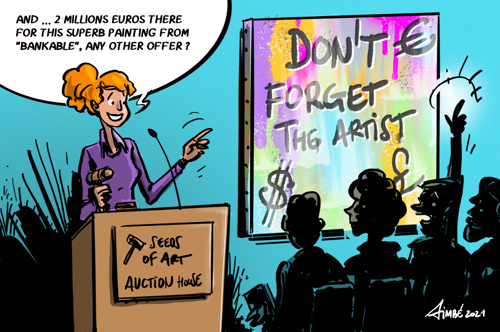- Art Law
- resale right , artwork , artist , artwork creator , copyright law , unique platform , artwork seller , artwork professional , auction house , resale royalties , art dealer , art trade
Although the resale right of the creator of a work of art exists in Belgium since 1921, the legal framework was only harmonised in 2001 following a EU Directive. This Directive made it mandatory for each Member State to implement rules regarding the exercise of the resale right. The twentieth anniversary of this Directive is the ideal moment to analyse how currently the resale right is implemented; especially in view of the changes made back in 2015, when the Copyright law was included in the Belgian Code of Economic Law.
1. What is the meaning of the Resale Right?
The resale right was already made part of the Belgian legal system in 1921, to be later incorporated in the Copyright Law of 1994. These days, this legal concept is enacted in the Belgian Code of Economic Law (Wetboek economisch recht/Code de Droit Economique) ("CEL").
The resale right is the right of an author to receive a fee based on the resale price, each time his original work of art is (re)sold, and where professional art dealers are involved.
The resale right can only apply to "original works of art", - works of graphic or plastic art -, provided that they are made by the artist or that the latter considers these to be original works of art. It can also cover copies, provided that they were made in limited numbers by the artist himself or under his authority.
The resale right is important to artists, as it gives them an opportunity to benefit from the value of artworks created by them, even after they have been sold. It also allows them to benefit from any added value created as their career evolves, or they become more widely known, and the value of their artworks increases.
2. Characteristics of the Resale Right
The resale right is the odd man out in copyright law.
The most significant consequence of this is its explicit characteristic that it is as an inalienable right of the author of public order. Any agreement to transfer such right will be null and void.
This specificity is to prevent that authors would be put under pressure to sell their resale rights along with their artworks. Conversely, it is likewise impossible to undertake never to invoke the resale right, and/or, to waive it.
In addition, the resale right only relates to the physical medium in which the original work of art is embodied. Any resale right can only arise at the resale of this medium. The resale right is considered to be a right to a compensation, but by no means an exclusive right.
The term of validity of the resale right is 70 years from the death of the author, as well as the other property rights of authors.
Similar to copyright, the resale right is acquired without any formalities.

3. The older rules were refined
Despite the harmonisation in 2001 of a number of important aspects that could mainly negatively affect the common market, each member state still has the power to determine for itself the manner in which authors can actually exercise and collect their resale right.
Whereas Belgian law initially favoured voluntary collective management, this was changed when the copyright law was integrated into the Code of Economic Law, to a system of mandatory collective management by means of a designated unique platform.
Indeed, voluntary membership of a collective management company made it difficult for art professionals to find out to who resale royalties should be paid and, all too often, in the end royalties were not paid. Also, the monitoring of it became very difficult.
In addition to minor modifications of the rules on the occasion of the insertion of these regulation into the Code of Economic Law, the statutory limitation period for claiming the resale right was extended to 5 years from the sale of the artwork.
4. The Belgian Resale Right: What, how and how much?
4.1 When does the resale right apply?
When a work of art is resold, and professionals from the art trade are involved, either as seller, buyer or intermediary, the author is owed a resale royalty.
No resale royalty is due on a work of art sold for up to 10,000 Euros, if the seller himself purchased the work from the author less than three years before reselling it. Art galleries and art dealers that promote young artists and make the necessary investments for the promotion and support (exhibitions, books and catalogues) can take advantage of this rule.
As the law only targets resales involving a professional, the resale right does not apply in case of:
- A direct resale between private persons without any participation of a professional;
- A resale to a museum which is not for profit and which is open to the public.
4.2 How much are the resale royalties?
A significant threshold governing the resale right stipulates that a resale royalty is only permitted on a sale for a price of more than 2,000 Euros. The Belgian legislator kept the threshold below the 3,000-Euro maximum threshold foreseen by the Resale Right Directive.
If a sale takes place, which satisfies the conditions, the resale royalty shall be calculated according to the following degressive rates:
|
Price |
Rate |
|
<2,000 Euros |
0% |
|
< 50,000 Euros |
4% |
|
50,000.01 Euros – 200,000 Euros |
3% |
|
200,000.01 Euros – 350,000 Euros |
1% |
|
350,000.01 Euros – 500,000 Euros |
0.5% |
|
> 500,000 Euros |
0.25% |
These rates are applied in price bands, the maximum amount being 12,500 Euros. This means that the resale right no longer increases once the price of a work of art exceeds EUR 2 million.
4.3 Who is entitled to the resale right?
The resale right is an inalienable right of the author of an original artwork.
Belgian law expressly states that the resale right also belongs to the heirs and other assignees of the author. Unless the latter has designated a specific person for this purpose, the copyright property rights will transfer to his heirs and legatees. It should be noted that certain member states limit these legal successors to the legal heirs what already has been accepted by the Court of Justice.
On the basis of European jurisprudence, each EU national has the right to enjoy the resale right arising in relation to his/her works in a different member state. For non-EU-nationals, the principle of reciprocal arrangement applies. Only if the third country also protects the resale right of the artist, these nationals may invoke it in Belgium.
4.4 Who must pay the resale royalties?
The CEL expressly mentions the seller’s obligation to pay resale royalties to the author. Nevertheless, the parties involved in a sale are always free to agree who will be liable to pay the resale royalty.
Belgian law provides for clear rules concerning the obligation of the parties involved in a sale to pay resale royalties.
For sales taking place in the context of a public auction, the intermediary seller and professional have the joint obligation to notify the unique platform (cf. infra) at the latest one month from the sale. They must pay the resale royalty, within two months of this notification, via the unique platform.
If the resale of an artwork does not take place within a public auction, the professionals together with the seller shall be jointly obliged to notify the unique platform, and thereafter pay the resale royalty due, within two months. In this context, professionals are obliged to provide the unique platform with a quarterly notification of the sales, on the basis of which the resale royalties payable have arisen.
In addition to the purchaser, the intervening professionals are therefore also jointly and severally liable for payment of the resale royalties.
5. How are Resale Royalties collected?
5.1 A unique platform is responsible for the exercise of the resale right
As already mentioned, in 2015 the system for collecting resale royalties was changed to a mandatory collective management system.
For this purpose, a unique platform was designated to ensure the exercise of the resale right. This platform was set up by the management companies responsible for managing the resale right, namely Sabam and Sofam.
This platform is currently organised via the website www.resaleright.be.
Sellers no longer have to identify the author entitled to royalties by themselves. Conversely, parties entitled to receive royalties from a resale are no longer able to collect the resale royalties owed to them directly from the sellers.
The unique platform of Sabam and SOFAM was placed in between them, to collect any resale royalties payable and to pay these to the authors (and/or successors).
Authors are free to approach the unique platform directly, if they don’t want to join a management company. The same applies for foreign individuals entitled to receive royalties, who must also contact the unique platform (www.resaleright.be).
Authors and persons entitled to receive royalties have a period of 5 years, counting from the resale, to claim their rights via the unique platform, and to obtain the resale royalties collected. All of this is made easier due to an obligation of transparency imposed on the unique platform. Indeed, the latter must keep a publicly accessible list of the sales notified to it. In this way, the website allows any author or person entitled to receive royalties to check the sales of its works of art in Belgium.
5.2 Right to information
The legislator has also elaborated an adapted right to information. This enables further monitoring of the declarations of sales and the payment of resale royalties by sellers and professionals.
The individual author or person entitled to receive royalties also have a right to receive information from the unique platform. They can request all relevant information to claim the resale royalty.
A request for information that is not respected, is subject to criminal sanctions. This clearly shows the importance attached to adequate transparency regarding the collection and payment of the resale right.
At the time of payment of the collected resale royalties by the unique platform, both non-members and members of management companies are charged various different costs.
6. Conclusion
The evolution and further adaptation of the resale right has strengthened its practical implementation and the possibility of collection.
Compulsory collective management with one unique platform (www.resaleright.be) placed between authors on one side, and sellers and art professionals on the other, created a simpler and more effective system.
On the one hand, the unique platform is responsible for collecting the resale royalties from sellers, and it has the authority and resources to do this. Hence, resale royalties are collected in a more consistent manner, and more frequently end up with the persons entitled to receive them.
This also increases clarity for art professionals.
And furthermore, authors and sellers/art professionals are no longer obliged to search for each other (often in vain) in order to collect or claim the resale royalty.
Authors (via their membership of a management company or not) have one clear direct point of contact, which is responsible for ensuring that resale royalties are collected and paid out on request.
Finally, the public list of sold works on the website www.resaleright.be makes it very simple for both foreign authors and artists to check whether any resale of their works has generated royalties in Belgium.
The modified operation of the resale right can therefore be regarded as positive, due to its more transparent and more effective system.
Should you like further explanation or assistance, please do not hesitate to contact us on +32 (0)2 747 40 07 or via info@seeds.law.
Read also



